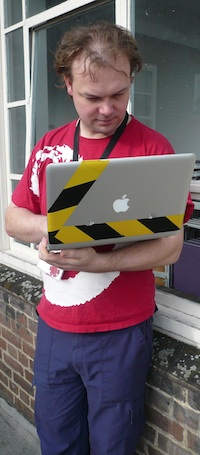Dev8D: Meet the organisers: Christopher Gutteridge
“If you want to be part of a community that’s enthusiastic and really cares, Dev8D and the associated community that has crystallised around it is for you,” says Christopher Gutteridge, Dev8D’s programme czar
I’m the linked open data “gardener” at University of Southampton and programme czar here at Dev8D
What does a programme czar do?
It involves worrying about one big aspect of the organisation so that Mahendra has more time to do the million other things he does, including making decisions about the structure of the programme and what’s going on where. My biggest achievement this year is my horizontal lines – there are horizontal lines across the whole programme rather than having lots of things overlapping. It increases the number of sessions people can go to because they do not have two sessions overlapping.
Apart from lack of overlap, what was the concept behind the programme?
In previous years people complained that they wanted to do some of the interesting stuff but felt they could not justify it if something else very relevant to their day-to-day work was happening at the same time. We have taken this on board and our solution is to divide the day up into thirds. So a third of the day is composed of things which you can show your boss and your boss will understand that they are worth getting you trained in. The second third is emerging technology – things you want to learn about but which might not make much sense to your boss. And a third of the day is a bit more relaxed and fun and open. We’ve divided it by time so that people no longer have to decide whether to do electronics or html because the extremely core stuff is in the morning sessions. This way everyone gets a balanced experience and doesn’t have to feel guilty about doing something fun at the end of the day.
You’ve put a lot of hard work into Dev8D, what are you hoping to get out?
The programme is built using technology we’ve used at Dev8D for about three years. It uses spreadsheets using google docs and every 10 minutes they are turned into RDF and then the website you see with the programme on is built on the fly from that data document. So there are two steps – creating an RDF document from a spreadsheet, taking the RDF document and making a website from it – and we are running workshops in both those steps. I’d like to see other people using the same document format for conferences and festivals and I’m hoping to get people to start to build more apps in a more mature version of this. If other conferences made their data in the same formats then the same apps would work for any conference and you wouldn’t have to keep reinventing the wheel. I would love to see big festivals like Glastonbury publish open data so people could make open apps.
How has Dev8D changed or evolved?
The community that is running Dev8D now is people who met at the first Dev8D. There wasn’t a community before that and now there is a group of people.
There is quite a wide range of skills and ages but everyone has the same enthusiasm – if you want to be part of a community that really cares and has that attitude, Dev8D and the associated community that has crystallised around it is for you.
Some of the way we run dev8d is fairly experimental and I mean that in the strict sense of the word – we will learn from what works and what doesn’t but we have minimised the risks so if the experimental parts don’t work then we still have a great event. And if they do work then it’s all the better for it!









0 Comments
Trackbacks/Pingbacks